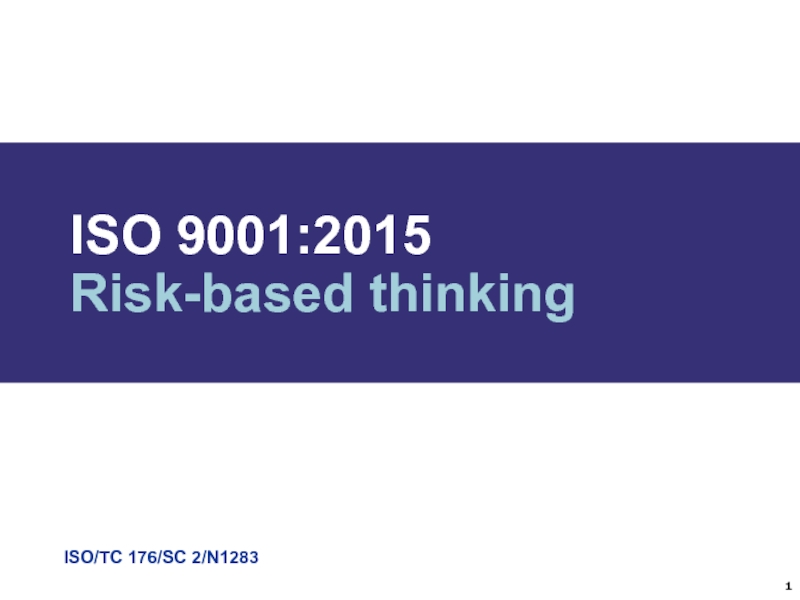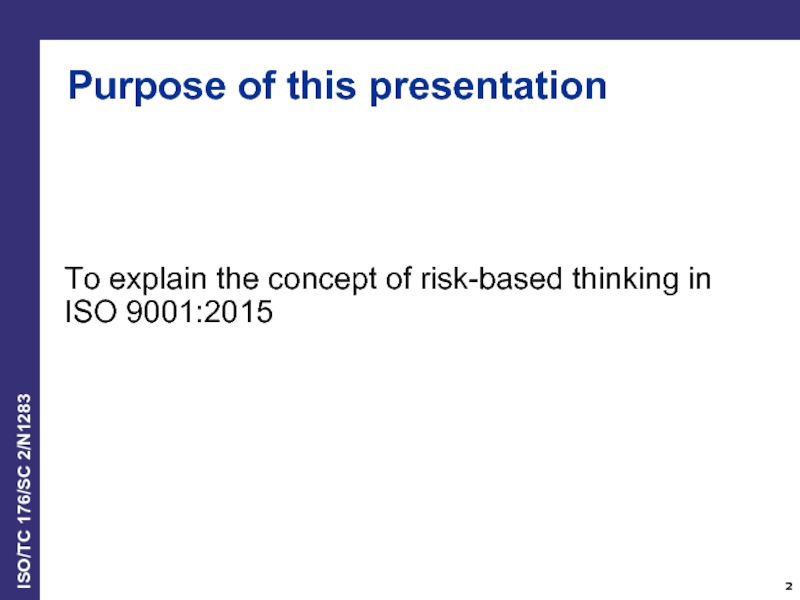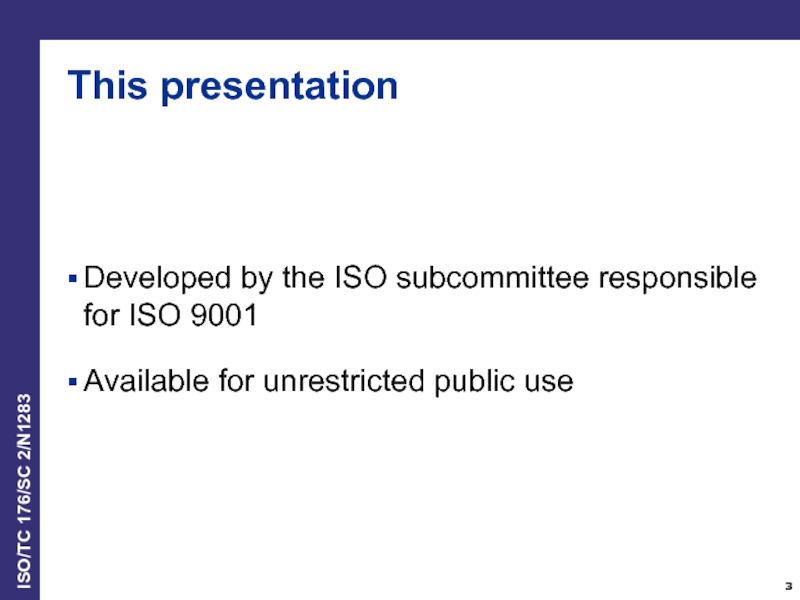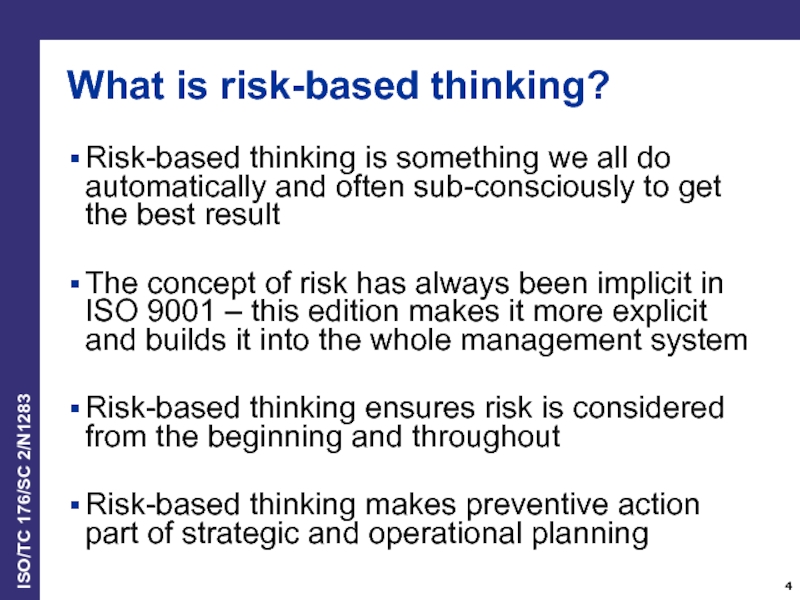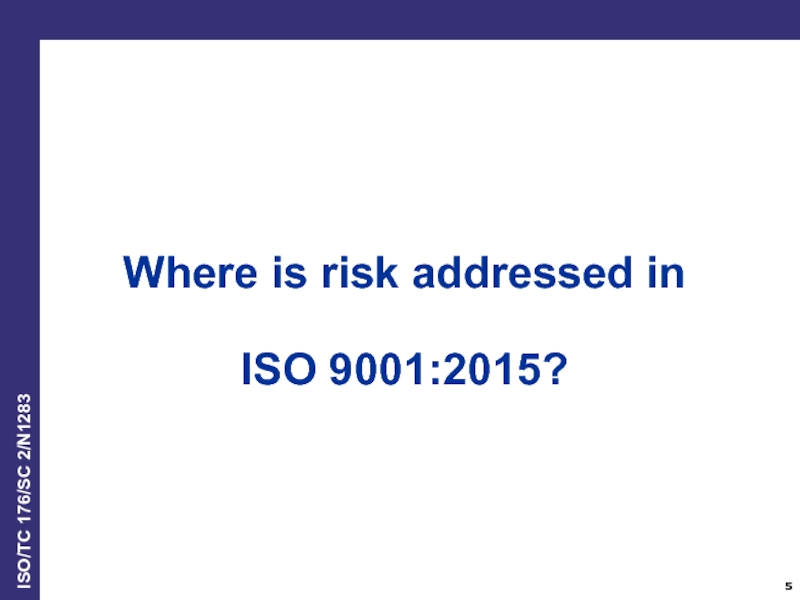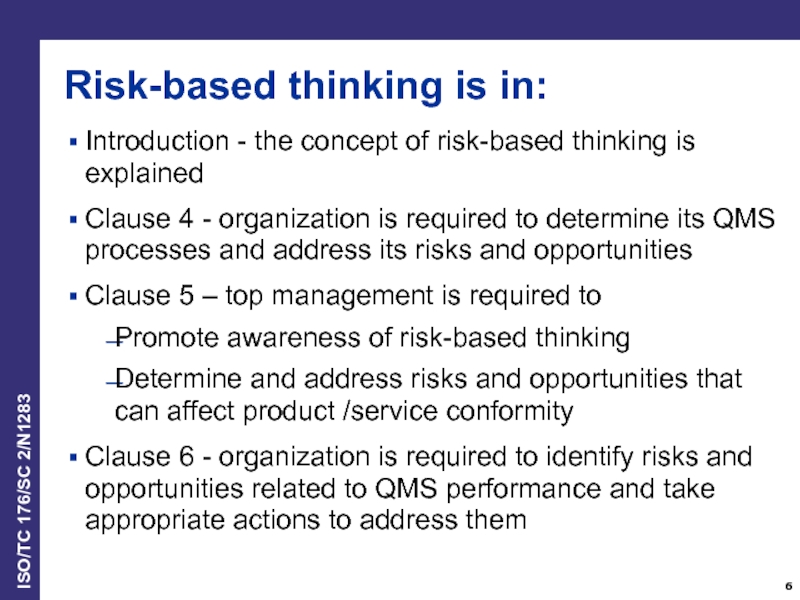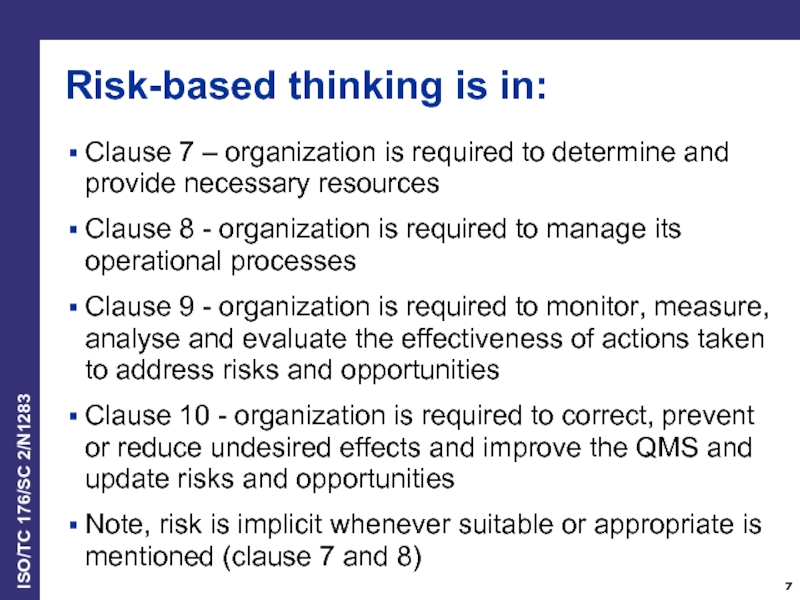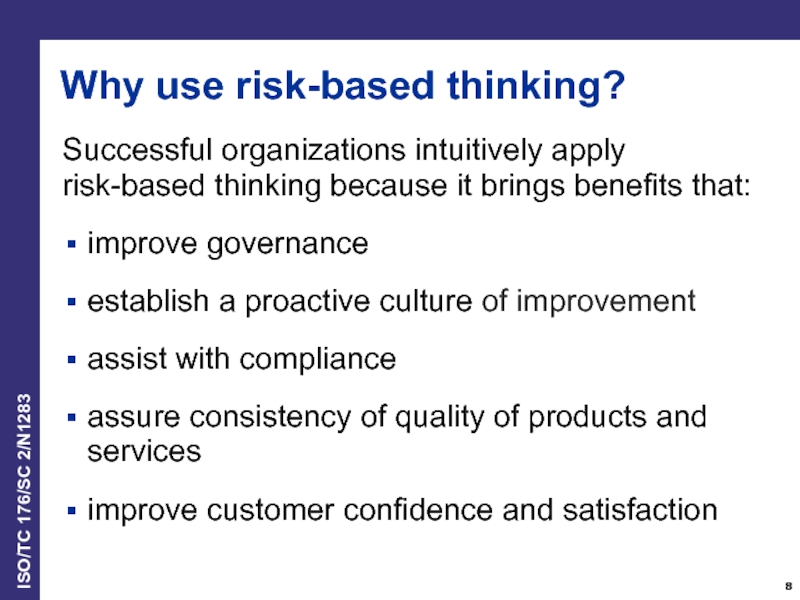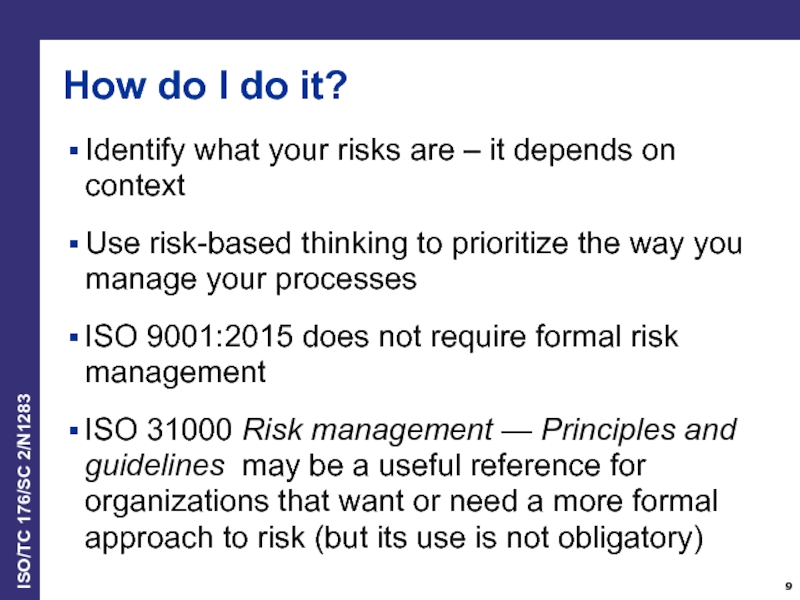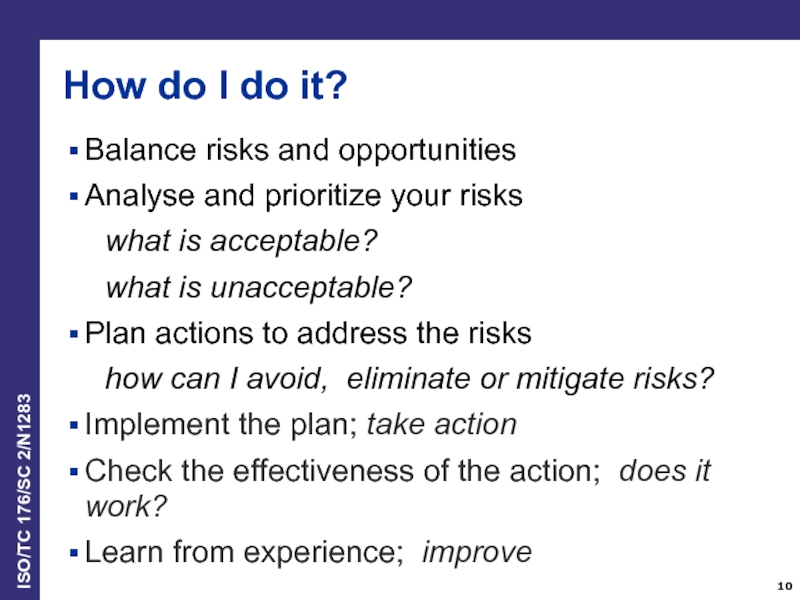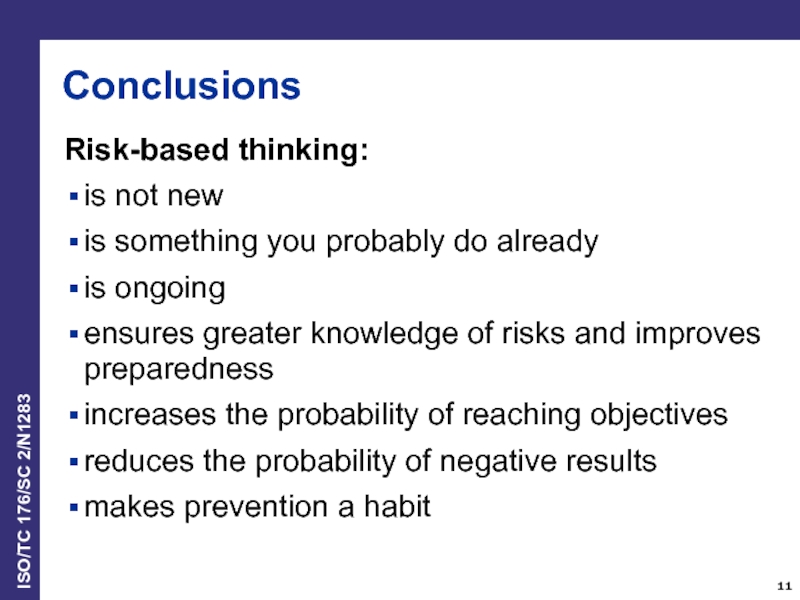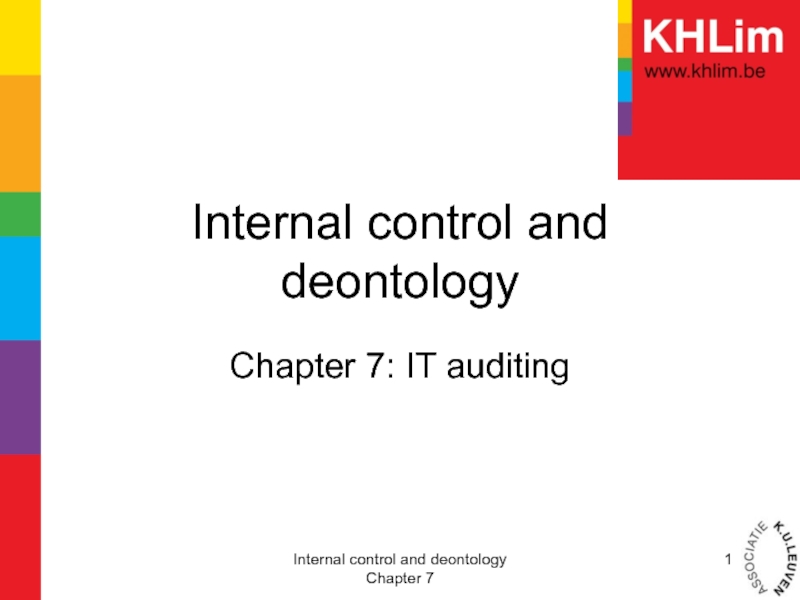- Главная
- Разное
- Дизайн
- Бизнес и предпринимательство
- Аналитика
- Образование
- Развлечения
- Красота и здоровье
- Финансы
- Государство
- Путешествия
- Спорт
- Недвижимость
- Армия
- Графика
- Культурология
- Еда и кулинария
- Лингвистика
- Английский язык
- Астрономия
- Алгебра
- Биология
- География
- Детские презентации
- Информатика
- История
- Литература
- Маркетинг
- Математика
- Медицина
- Менеджмент
- Музыка
- МХК
- Немецкий язык
- ОБЖ
- Обществознание
- Окружающий мир
- Педагогика
- Русский язык
- Технология
- Физика
- Философия
- Химия
- Шаблоны, картинки для презентаций
- Экология
- Экономика
- Юриспруденция
ISO 9001:2015. Risk-based thinking презентация
Содержание
- 1. ISO 9001:2015. Risk-based thinking
- 2. To explain the concept of risk-based
- 3. This presentation Developed by the ISO subcommittee
- 4. What is risk-based thinking? Risk-based thinking is
- 5. Where is risk addressed in ISO 9001:2015?
- 6. Introduction - the concept of risk-based thinking
- 7. Risk-based thinking is in: Clause 7 –
- 8. Why use risk-based thinking? Successful organizations
- 9. How do I do it? Identify
- 10. How do I do it? Balance risks
- 11. Conclusions Risk-based thinking: is not new is
Слайд 3This presentation
Developed by the ISO subcommittee responsible for ISO 9001
Available for
unrestricted public use
Слайд 4What is risk-based thinking?
Risk-based thinking is something we all do automatically
and often sub-consciously to get the best result
The concept of risk has always been implicit in ISO 9001 – this edition makes it more explicit and builds it into the whole management system
Risk-based thinking ensures risk is considered from the beginning and throughout
Risk-based thinking makes preventive action part of strategic and operational planning
The concept of risk has always been implicit in ISO 9001 – this edition makes it more explicit and builds it into the whole management system
Risk-based thinking ensures risk is considered from the beginning and throughout
Risk-based thinking makes preventive action part of strategic and operational planning
Слайд 6Introduction - the concept of risk-based thinking is explained
Clause 4 -
organization is required to determine its QMS processes and address its risks and opportunities
Clause 5 – top management is required to
Promote awareness of risk-based thinking
Determine and address risks and opportunities that can affect product /service conformity
Clause 6 - organization is required to identify risks and opportunities related to QMS performance and take appropriate actions to address them
Clause 5 – top management is required to
Promote awareness of risk-based thinking
Determine and address risks and opportunities that can affect product /service conformity
Clause 6 - organization is required to identify risks and opportunities related to QMS performance and take appropriate actions to address them
Risk-based thinking is in:
Слайд 7Risk-based thinking is in:
Clause 7 – organization is required to determine
and provide necessary resources
Clause 8 - organization is required to manage its operational processes
Clause 9 - organization is required to monitor, measure, analyse and evaluate the effectiveness of actions taken to address risks and opportunities
Clause 10 - organization is required to correct, prevent or reduce undesired effects and improve the QMS and update risks and opportunities
Note, risk is implicit whenever suitable or appropriate is mentioned (clause 7 and 8)
Clause 8 - organization is required to manage its operational processes
Clause 9 - organization is required to monitor, measure, analyse and evaluate the effectiveness of actions taken to address risks and opportunities
Clause 10 - organization is required to correct, prevent or reduce undesired effects and improve the QMS and update risks and opportunities
Note, risk is implicit whenever suitable or appropriate is mentioned (clause 7 and 8)
Слайд 8
Why use risk-based thinking?
Successful organizations intuitively apply risk-based thinking because it
brings benefits that:
improve governance
establish a proactive culture of improvement
assist with compliance
assure consistency of quality of products and services
improve customer confidence and satisfaction
improve governance
establish a proactive culture of improvement
assist with compliance
assure consistency of quality of products and services
improve customer confidence and satisfaction
Слайд 9How do I do it?
Identify what your risks are –
it depends on context
Use risk-based thinking to prioritize the way you manage your processes
ISO 9001:2015 does not require formal risk management
ISO 31000 Risk management — Principles and guidelines may be a useful reference for organizations that want or need a more formal approach to risk (but its use is not obligatory)
Use risk-based thinking to prioritize the way you manage your processes
ISO 9001:2015 does not require formal risk management
ISO 31000 Risk management — Principles and guidelines may be a useful reference for organizations that want or need a more formal approach to risk (but its use is not obligatory)
Слайд 10How do I do it?
Balance risks and opportunities
Analyse and prioritize your
risks
what is acceptable?
what is unacceptable?
Plan actions to address the risks
how can I avoid, eliminate or mitigate risks?
Implement the plan; take action
Check the effectiveness of the action; does it work?
Learn from experience; improve
what is acceptable?
what is unacceptable?
Plan actions to address the risks
how can I avoid, eliminate or mitigate risks?
Implement the plan; take action
Check the effectiveness of the action; does it work?
Learn from experience; improve
Слайд 11Conclusions
Risk-based thinking:
is not new
is something you probably do already
is ongoing
ensures greater
knowledge of risks and improves preparedness
increases the probability of reaching objectives
reduces the probability of negative results
makes prevention a habit
increases the probability of reaching objectives
reduces the probability of negative results
makes prevention a habit
